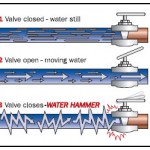
Have you ever heard a loud banging noise when you turn off the water in your home? Maybe it only happens when you flush a certain toilet or when you do the laundry. What you are hearing is called ‘water hammer’. It’s a kind of hydraulic shock that occurs when moving water comes to a sudden stop.
As a professional home inspector with a leading Buffalo and Western New York home inspection company, I have seen and heard my share of water hammer and banging pipes.
Initially, the problem may not do much damage other than create a nuisance. However, over time, the damage could become quite significant if the continued shock and vibrations cause a pipe or connection to break. That said, it is best to deal with the issue sooner than later.
Without getting too technical, the cause of water hammer is basically the flow of water coming to a sudden stop with the resultant excess energy transferred to the walls of the pipe, which in turn vibrate or bang against other pipes or structural members.
QUICK FIX
Any homeowner can tackle the quick fix method and quite often meet with success. Simply, turn off the water to your house at the meter. Open the faucet farthest from the meter as well as the lowest or closest one to the meter. In so doing, you are effectively draining the plumbing system of its water. You are also potentially restoring air chambers to act as a sort of shock absorber inside the pipes.
Once the water has been drained, close all the faucets and turn the water back on. This should resolve any water hammer problems but do not be surprised if it is not a permanent fix and needs to be repeated at some point in the future. Also, when you turn the faucets on for the first time you will experience some sputtering of air from each faucet.
You should also check all pipe runs to make sure they are securely attached to a structural member to minimize movement of the pipes.
MORE PERMANENT FIX
A more permanent fix provides for the installation of ‘water hammer arrestors’ near each offending valve or faucet. These devices have a piston or diaphragm and air or gas chamber to absorb the excess energy when the flow of water is suddenly stopped. They should be properly sized, positioned and installed by a licensed plumber.
Alternatively, installing larger pipes, a pressure reducing valve and/or an expansion tank can also fix the problem. However, installing larger pipes is a pretty extensive (and expensive) effort and can be avoided fairly easily with the other options.
___________________________________________________________________
Lawrence Watkins is a NYS Licensed Home Inspector and the President of Specsure Property Inspections. As a leading full service residential home inspection and commercial property inspection company proudly serving Buffalo, Lewiston, Orchard Park and all of Western New York (WNY) for over 20 years, we are pleased to provide timely and simple DIY tips and hints for today’s homeowner.
For more information you can reach us at 716-881-1914 or via email at info@specsure.com


